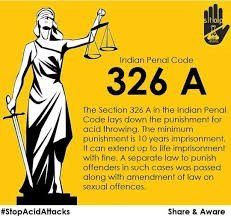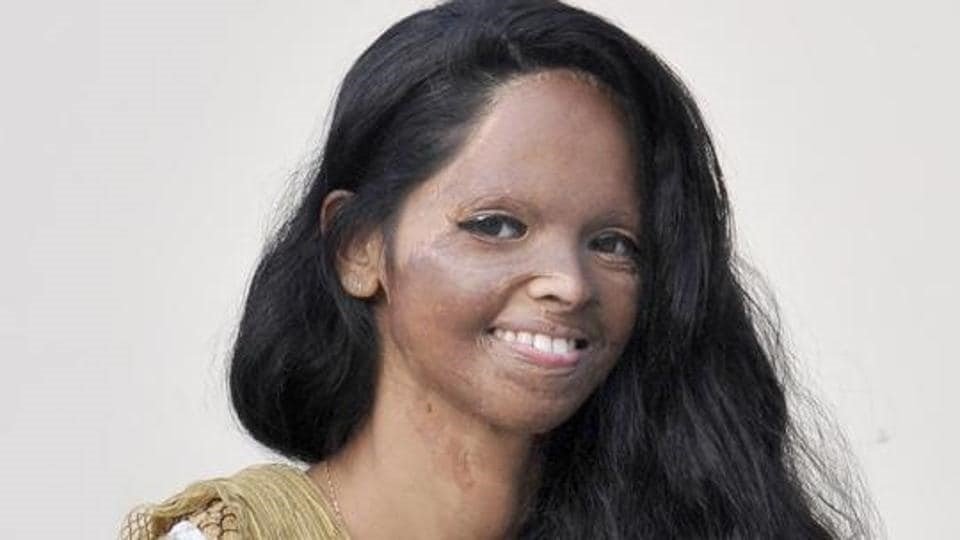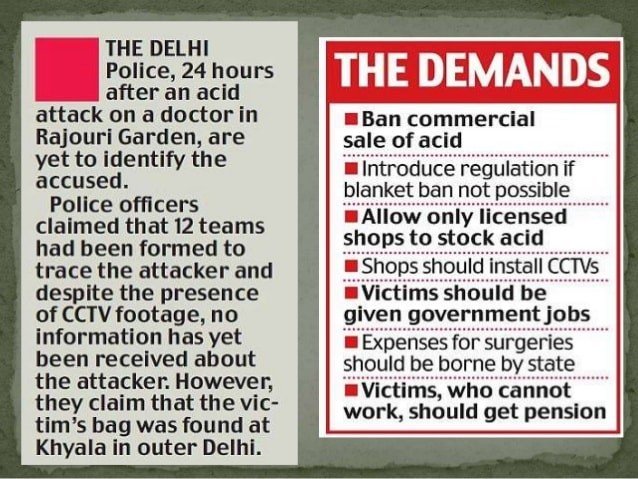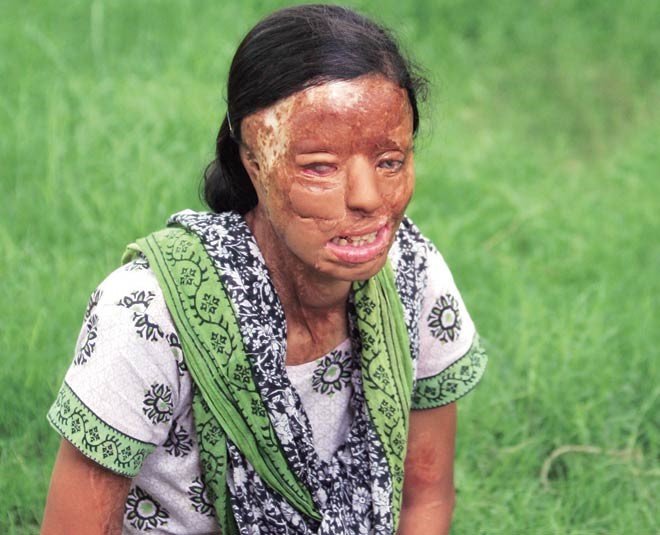ACID ATTACK
INTRODUCTION
Acid attack or vitriol attack is defined as the attack of throwing acid onto the body of person “with the intention of injuring or disfiguring them out of jealousy or revenge”.
Acid violence reflects gender inequality and discrimination in the society. Of all the gender-based violence directed at women, one of the most horrific is acid attacks. Historically, a vast majority of attacks are against women with 99% of the perpetrators being men. Indeed a significant portion of attacks occur when a woman exercises decision making power by rejecting a marriage or love proposal. Men, who are involved in a dispute, will permanently mutilate unsuspecting women by throwing acid on their faces or genitals causing excruciating pain and sometimes blinding, causing loss of hearing or killing their victims. The victim is traumatized not only physically but also psychologically because an irreparable injury is inflicted on one of the most prized possession of a woman, her beauty. The scars left by acid are not just skin deep, victims are most often faced with social isolation and ostracization that further damages their self esteem, self-confidence and seriously undermines their professional and personal future. Women who have survived acid attacks have great difficulty in finding work and if unmarried, as many victims tend to be, they have very little chance of ever getting married. Also, in most of the cases, the women are unable to bear the cost of treatment and horrified by their condition, they end their lives.
Reasons for Acid attacks: Acid attacks in India are committed for various reasons, however, a majority of cases can be tied to India’s patriarchal society. The motives include:
• refusal to marry (Ramesh Dey and Ors. v. State of West Bengal, 2006; Nazeem Khan v. State, 2009; Sikandar Kumar v. State of Punjab, 2016);
• Personal enmity of the husband to the victim (Syed Shafique Ahmed v. State of Maharashtra, 2001);
• Suspicion or knowledge of an extramarital affair (Balu v. State, 2004); ending/discontinuance of an extramarital affair (Mahadeva Madeva Shisthu v. The State of Karnataka, 2005); refusal to rejoin the previous job (State of Karnataka v. Joseph Rodrigues, 2006);
• Refusal of wife to cohabit with husband (Devanand Vs. The State)
• refusal to accept requests of sexual advances (Parivartan Kendra v. Union of India, 2015);
• Non-acceptance of marriage prospects either by the accused’s family or by the victim’s family (Sabana Khatun v. The State of West Bengal & Ors., 2014; Ravada Sasikala v. State of Andhra Pradesh and Anr, 2017);
• Jealousy of the victim’s beauty (Simran Meena Khan v. State, 2016);
• jealousy of the victim’s success and job (Shah, 2016);
• property dispute with the victim’s family (Yogesh Jain v. Vipin Jain, 2016); and
• Other personal enmities with the victim or victim’s family (Suresh & Ors v. State of Haryana, 2016).
Prior to the 2013 Criminal Amendment Act, the Indian legal system was woefully inadequate to address acid attacks as it had neither sufficient provisions to punish (or deter) the crime nor adequate resources to compensate victims. Prior to 2013, perpetrators were charged with voluntary causing hurt, voluntarily causing grievous hurt, voluntary causing hurt by means of dangerous weapons such as heated substances, voluntary causing grievous hurt by means of dangerous weapons such as corrosive substances, or murder. These offenses were available under the Indian Penal Code (1860) (hereinafter IPC), but prosecutions were problematic due to the broad and generalized nature of the laws, and because the laws were inadequate to encompass the nature of or facilitate convictions of perpetrators.
The increased incidents of acid attacks have resulted into addition of Section 326-A in IPC which punishes acid attacker with minimum of 10 years imprisonment. This is a commendable measure by the legislature to prevent this barbaric offence which is not only an offence against human body but also the grossest violation of right to life which includes right to live with human dignity.

LAXMI AGGARWAL CASE
It is to be considered that earlier the act of committing the offence of acid attack was covered under the ambit of grievous hurt under section 320 of IPC but after the judgment of this landmark case, it provided light to those survivors who have been suffering from so many years due to lack of separate laws and social orders.
The laws which were inserted in the form of provisions for prosecuting the culprits were highly absurd, a loophole that exists in the society one or another way hampered the concept of equity and good conscience. The reality of suffering the pain of acid and the impact of such an offence on the life of an individual is a much deeper concept than the meaning of grievous hurt as mentioned in IPC.
Therefore, there was a dire necessity to provide the laws, particularly for such odious offence. The victims of acid attack survivors breathed a sigh of relief after seeing this judgment and directions from the Apex court. This judgment set a precedent for other contingencies which may arise further.
Earlier, due to lack of provisions on punishment for acid attack, the victim has had no remedy left but was compelled to bring his case within the ambit of section 307 of IPC (Attempt to commit Murder) with respect to prosecuting the accused with higher punishment which could not be done under section 326A and 326B , where having been unable to prove the injuries that could lead to the death of the victim extinguish their hope of attaining justice from the court.

FACTS: In 2005, when Laxmi was 15 years old and a 7thgrade student, she was approached by a man working in her neighbourhood, Naeem Khan, who was 32 years old. He proposed Laxmi but she rejected him. She did not inform anyone about this because her family would’ve blamed her and stopped her studies. 10 months later, Laxmi was walking from Khan Market at 10:45 in the morning, when she received the same message from Naeem that he loves her and wants to marry her. She did not respond. In no time, she was attacked with an acid by Kamran (Naeem's older brother) and his girlfriend, Rakhi. Kamran called Laxmi's name from behind while riding his motorcycle. When Laxmi looked behind as a response to her name, Rakhi threw acid directly at her face from back seat. Laxmi fainted for a bit and after gaining consciousness, she tried to walk up and ask for help but met multiple road accidents. A man named Arun Singh called PCR but he saw her skin melting with the acid and realised it might be too late to wait for the police. Someone splashed water on her face hoping to reduce the burns but this caused the acid to move down and burn her neck. Arun then somehow got her in the back seat of his car. This later caused burn holes in the seat covers. He admitted her in Ram Manohar Lohia Hospital. The police reached the hospital directly. Arun then asked Laxmi about her family and where she lived. He reached her house, informed her family and picked them from their house to the hospital. She underwent multiple operations including an eye surgery. 4 days after the attack, Naeem Khan was arrested, after widespread protests and media attention, he was sentenced to prison for life.
PIL – LAXMI V. UNION OF INDIA: Her PIL sought framing of a new law or amendment to the existing criminal laws like IPC, Indian Evidence Act and CrPC for dealing with the offence besides asking for compensation. She also pleaded for a total ban on sale of acid citing an increasing number of incidents of such attacks on women across the country. Following a writ petition by Laxmi in 2006, the Supreme Court, in July 2013, passed orders that led to the regulation of the sale of acid, compensation for the victims, after-care and rehabilitation of the survivors, limited compensation from the government, reservation in educational institutions and easier access to jobs.

Summary of main issues concerned in the case:
1. To make strict laws and sentence by making significant amendment in the Penal Code and Procedural law relating to acid attack offence
2. To completely prohibit the vending of acid and its distribution in the shops to prevent easy availability.
3. To reintegrate and recompense the victim of acid attack survivor.
As per the directions of the Supreme Court, Draft Model Poison Rules 2013 were formulated by the Ministry of Home Affairs based on the Poison Rules of States of Karnataka, Punjab, Maharashtra and Kerala.
The list of acids identified are those which have a pH of 0-2 and are strongly acidic and those which are strongly alkaline between pH of 11.5 to 14 and have the ability to cause dermal corrosion. There are other poisons which are not corrosive but are nevertheless toxic to life which may be identified separately and added to the Schedule by the State/UT.
The crucial step from this case is the amendment in the laws for acid attack offence in the Penal code by insertion section 326A and 326B relating to the laws and punishment of throwing acid offence and in Crpc section 357A and 357C was inserted which provides compensation to the acid attack survivors and treatment of acid attack victims to be free of cost in both public and private sector of hospitals.
GUIDELINES ISSUED: Vide this judgment, the Supreme Court observed that the following action would need to be taken immediately in the State/UT to regulate sale of acid/corrosive substances -
1. Banning over the counter sale of acid/corrosives unless the seller maintains a logbook/register recording the sale of acid and specify the reason/purpose for procuring acid
2. A sale will be made only when the buyer produces a photo ID issued by the Government with address and proves that he/she is above 18 years of age.
3. Implement the direction of the Supreme Court whereby acid attack victims should be paid compensation of at least Rs. 3 lakhs by the concerned State Government/Union Territory as the after care and rehabilitation cost. Rs 1 lakh shall be paid to such victim within 15 days to facilitate immediate medical attention and expenses and balance sum of Rs. 2 lakhs should be paid as expeditiously as may be possible and positively within two months thereafter (Pursuant to Supreme Court direction in Writ Petition of Laxmi v. Union of India, the Ministry of Home Affairs issued guidelines for ‘Central Government Victim Compensation Fund Scheme’ to help women of various crimes especially sexual offence like rape, acid attack, crime against children, etc. An additionalRs.1lakh compensation under Prime Minister’s National Relief Fund is decided to be given over and above the compensation under Victim Compensation Scheme (i.e. Rs. 3 lakh compensation as per the direction of the Supreme Court)
4. All Central Govt. hospitals and establishments had already been directed to treat acid attack victims free of cost.
SONALI MUKHERJEE CASE
SONALI MUKHERJEE V. UNION OF INDIA, 2019

Sonali Mukherji was sexually abused by three males for years who later on spilled acid on her face and scarred her for life. The three - Tapas Mitra, Sanjay Paswan and BhrahmadevHajra lived near Mukherjee's home and sexually abused her. On 22 April, when there ill motives did not succeed, they, in order to teach her a lesson, went to her home and spilled burning acid on her face while she was sleeping on the roof of her house with her family. Her sister was also injured in the incident.
The perpetrators were sentenced to nine years in jail by the Trial Court but were granted bail from the High Court of Jharkhand. Then victim approached the court and various other authorities for justice including the Chief Ministers Shibu Soren, Arjun Munda and Madhu Kodabut nothing happened. In February 2014, State Govt. of Jharkhand appointed Sonali Mukherjee as Grade III clerk in the welfare department of the Bokaro Deputy Commissioner's office.
She has undergone 25 surgeries in 10 years and excruciating pain just to look human again. Her father lost his ancestral land and all the savings to her 22 odd injuries. With more than 60-70% of her skin burnt, she now feels the chill at 22 degrees Celsius and cannot bear the heat beyond 25 degrees.
Fed up with the endless sufferings and of the entire struggle that she demanded euthanasia. It was then that media caught attention of her and gave her the platform to take her voice to the public.
PARIVARTAN KENDRA V. UNION OF INDIA
The case highlights the deficiency and inadequacy of authoritative measures to manage acid attacks. Parivartan Kendra, a registered NGO had documented and filed a writ petition as Public Interest Litigation in the Supreme Court of India under its original jurisdiction as Art. 32 of the Indian Constitution to address the predicament of victims of acid attack significantly after its judgment in Laxmi v. Association of India and Ors.[1] (in Writ Petition (Crl.) No.129 of 2006). The Petition also brings into light the legal features like the absence of a legal assurance to free medical facilities, rehabilitative facilities, or satisfactory remuneration under the Survivor Compensation Schemes.
BRIEF FACTS: The petitioner, Parivartan Kendra (N.G.O.) took up the case of two young girls in Bihar, who were assaulted around 12 AM of October 21, 2012, by four men who tossed acid on the face and bodies of both the sisters while they were sleeping on the roof of their house. It is contended by the petitioners that these attackers used to tease the elder sister while she was going to work. While doing an acid attack on the elder sister, the acid also fell on the younger one and damaged her arms. After the assault, the girls screamed for help. Upon this, the attackers fled. The family took the victim to Patna Medical College. The petitioner further contended that the doctors showed up just the following morning and didn’t give them the required treatment and the family needed to purchase all the prescriptions all alone. The family was disregarded beings Dalits. From that point, the victim’s family was given Rs.2, 42, 000/ – from the Government of Bihar for the treatment of both which is not sufficient as the expenses incurred were around Rs.5, 00,000. Moreover, even the complaint was not lodged by the police immediately. The delay in her treatment because of hospital administration worsened her condition. The attack disfigured her face completely. The family was neglected by the hospital authorities as they belong to the lower caste. Even the police didn’t record the case until pressure was made by media. The culprits were captured one month after the occurrence. Be that as it may, the policed didn’t record any announcement from casualties. After a long battle, her father got compensation of Rs. 3 Lakhs which was lacking to cover the debts. The father of the victim has finally approached the petitioner who filed a writ petition against the culprits under Article 32 of the Constitution of India.
DECISION OF THE COURT: The Supreme Court held that the guidelines issued in the case of Laxmi v. Union of India is adequate except for the aspect of compensation given to the survivor. Rs. 3 Lacs accommodated as compensation for Laxmi’s situation ought to be treated as a minimum amount to be given and states could accommodate more pay according to the requirements and conditions of the case. The court permitted a pay of Rs. 10 Lakhs for Chanchal and Rs. 3 lacs for her younger sister to be paid within a certain period from the date of the ruling. It also ordered the state to make legal provisions for involving acid attack victims in the disability list i.e. the list of disabled people.
As a result of this judgment, acid attack survivors in India are now given rights under the Rights of Persons with Disabilities Act, 2016
(PREETI RATHI CASE) STATE OF MAHARASHTRA V. ANKRUR PANWAR, SEPTEMBER 2016
In the first such order in an acid attack in Maharashtra a special women’s Court here sentenced Ankur Panwar to death. The accused was convicted of the charge of throwing acid on Preeti Rathi at Bandra station in 2013 after she chose to pursue her nursing career, declining his proposal for marriage. Special Judge Anju S. Shende said “According to the mitigating and aggravating circumstances, the facts of the case and the recent acid attack judgments by the Supreme Court, the accused to death.
Conclusion: An acid attack has long-lasting consequences on the life of the victim who faces perpetual torture, permanent damage and other problems for the rest of her life. Their living life becomes very tough; they become too traumatized and embarrassed to walk out of their house and carry out simple tasks let alone get married, have children, get a job, go to school, etc. Even if they are willing to pursue a normal life, there is no guarantee that society itself will treat them as normal human beings given their appearance and disabilities after an attack. They may not be able to work, or be able to find a job, and thus perpetually struggle to survive. Therefore, to curb attacks on women harsh punishment should be given to person so that they feel the same as the victim feels.
The Crime of an Acid attack is not on a small range, day by day the crime of acid attack is increasing so government should take appropriate action which actual will help the victim.
